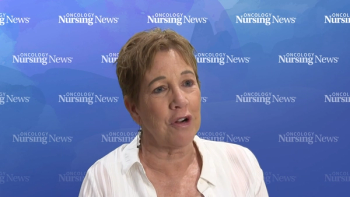
Using liquid biopsies to test for ESR1 mutations in breast cancer is more feasible for patients and has quicker turnaround times.

Using liquid biopsies to test for ESR1 mutations in breast cancer is more feasible for patients and has quicker turnaround times.

The accelerated approval for nivolumab monotherapy in unresectable/metastatic MSI-H/dMMR CRC has also been converted to regular approval.

VXM01 plus avelumab was tolerable and could potentially produce clinically meaningful responses in patients with recurrent glioblastoma.

Practicing at top of licensure can create opportunities for oncology APPs to engage with patients and other providers in new ways.

Axi-cel, tisa-cel, and brexu-cel were found comparable to other cellular therapy experiences for patients with B-cell malignancies in real-world data.

Oncology nurses can enhance endometrial cancer recovery by fostering strong social support networks and improving communication with the patient.

Chemotherapy regimens chosen by the ChemoID assay dramatically increased ORR in patients with platinum-resistant ovarian cancer.

Working with patients in new contexts can provide meaning for oncology PAs, potentially reducing burnout, according to Eric Tetzlaff, MHS, PA-C, DFAAPA.

Biocartis announced the launch of its real-time quantitative polymerase chain reaction assay to detect POLE and POLD1 mutations in endometrial cancer.

Katherine Cohen, MSN, FNP-C, provided insights on what to consider when treating patients with HR+, HER2- breast cancer in the second line of treatment.

The combination of amivantamab and Lazertinib improved long-term survival over osimertinib in patients with EGFR-mutated non-small cell lung cancer.

Documentation is especially important for nurse practitioners in cancer research and can lead to improved patient recruitment, says an expert.

Per phase 2 trial data, enhanced dermatologic management showed a reduction in dermatologic AEs in patients with advanced EGFR-mutated NSCLC.

The FDA approved treatments in various gastrointestinal and genitourinary cancers in March.

Rates of pay, bonus pay, and changes to funding for continuing education were not significantly linked with burnout rates.

Relacorilant in combination with nab-paclitaxel yielded higher PFS and OS in patients with platinum-resistant ovarian cancer vs nab-paclitaxel alone.

Osimertinib monotherapy and combination treatment had safety profiles consistent with previous data on use of the drug in EGFR-mutated NSCLC.

Elotuzumab plus pomalidomide, bortezomib, and dexamethasone showed tolerability in patients with relapsed or refractory multiple myeloma.

The complete response letter, issued by the FDA, does not identify what deficiencies regulators found in camrelizumab/rivoceranib for advanced HCC.

The FDA has approved neoadjuvant durvalumab plus chemotherapy followed by adjuvant durvalumab after radical cystectomy in MIBC.

Debriefing after patient loss, supporting patients at the end of life, and finding outlets outside of work can help oncology nurses avoid burnout.

Indications for 177Lu-PSMA-617 now include taxane-based chemotherapy naive adults with PSMA+ mCRPC.

Seth Eisenberg, ASN, RN, OCN, BMTCN discussed the results of a real-world trial of Splashblocker, a toilet seat cover designed to mitigate exposure to toxins.

Oncology nurses play a key role in advocating for metastasis-directed therapy in prostate cancer.

Evaluation of nemvaleukin for platinum-resistant ovarian cancer will be terminated based on OS data from an interim analysis of the phase 3 ARTISTRY-7 trial.

The safety and efficacy of dostarlimab plus chemotherapy in patients with advanced endometrial cancer were confirmed by results of a real-world study.

The FDA approved cabozantinib for use in patients with previously treated unresectable, locally advanced or metastatic, well-differentiated epNETs or pNETs.

The presence of biomarkers, even in small amounts, can shape the course of treatment for a patient, says Andy Guinigundo, MSN, RN, CNP, ANP-BC.


Jessie Desir, PhD, RN, AMB-BC, OCN, explained that comprehensive disease and treatment education are essential to adherence for patients with breast cancer.